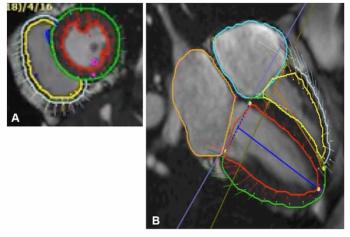
- Diagnostic Imaging Vol 32 No 9
- Volume 32
- Issue 9
Cardiac MRI shows heart adaptations in triathletes
MRI was able to reveal changes to the heart and vessels of athletes who trained for triathalons, according to a study conducted at the University of Erlangen-Nuremburg in Germany.
MRI was able to reveal changes to the heart and vessels of athletes who trained for triathalons, according to a study conducted at the University of Erlangen-Nuremburg in Germany.
In a study comparing 26 professional male triathletes and 27 male controls, cardiac MRI revealed the triathletes had larger left atria and larger right and left ventricles. The triathletes' ventricles also had greater muscle mass and wall thickness, the study found (Radiol doi:10.1148/radiol.10092377).
In competitive athletes, it's important to distinguish physiological adaptations as a result of training from pathological conditions such as cardiomyopathy, which is the most common cause of sudden cardiac death. Cardiomyopathy is present when the size of the heart's four chambers and the thickness of the heart wall become asymmetrical, so the heart is unable to pump effectively.
The triathletes had a balanced increase in left and right ventricular muscle mass, wall thickness, dilation, and diastolic function.
Articles in this issue
about 15 years ago
Overlap shifts to help urgent findings communicationabout 15 years ago
Spectral CT IDs heart plaque better than conventionalabout 15 years ago
MRI, MRS scans reveal who will lose weightabout 15 years ago
Sheryl Crow teams up with breast cancer centerabout 15 years ago
New meaningful use rules spell opportunity for radiologyabout 15 years ago
Meaningful use: The government's billion dollar gift to radiologistsabout 15 years ago
MSCT moves ahead of DSA for peripheral arterial diseaseabout 15 years ago
CT and MRI drive awareness of vascular liver disordersabout 15 years ago
In a disaster, Homeland Security has plans for youabout 15 years ago
In overutilization, some practices more culpableNewsletter
Stay at the forefront of radiology with the Diagnostic Imaging newsletter, delivering the latest news, clinical insights, and imaging advancements for today’s radiologists.


























